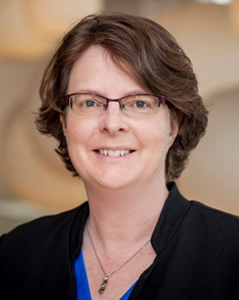

Dr. Kathleen J. Millen, Ph.D.
Professor of Pediatrics, University of Washington | Associate Director, Center for Integrated Brain Research, Seattle Children’s Research Institute | Seattle, WA
In each newsletter, we are profiling one of our Dandy-Walker Alliance Scientific and Medical Advisory Board members. For June, our Executive Director Chris Rogers sat down with Dr. Kathleen Millen, Ph.D., from the University of Washington and Seattle Children’s Research Institute.
Dr. Millen is a professor and researcher focusing on brain development, including the cerebellum. Together with Dr. Bill Dobyns, Dr. Kimberly Aldinger, and others, she has led the charge in Dandy-Walker research over the last decade-plus.
This interview has been edited for brevity and clarity.
Dr. Millen, thank you for joining me today. Tell me a little bit about yourself. What is your official title, and what does your work entail?
I am a Professor of Pediatrics at the University of Washington. I am also, the Associate Director of the Center for Integrative Brain Research (CIBR) at Seattle Children’s Research Institute.
What it means is that in addition to running my own research lab, I help run CIBR. I help with many administrative and organizational tasks required to keep a large group of researchers all studying multiple aspects of pediatric brain disorders functioning within the institution.
What made you interested in brain development? What about cerebellar development specifically?
I have been interested in studying development since I was an undergraduate, at the end of my first year of university. I was visiting a research lab and watched in real time a worm embryo divide from one cell to two cells to four cells. It was entrancing! How can one fertilized cell form into an entire being? That was the question that hooked me from the very beginning.
In graduate school, I had the choice to study multiple aspects of development, but I was really interested in the brain, because it’s so complicated and amazing. I wanted to learn out how it all comes together and how it works.
I was in graduate school at the very beginning of genome engineering revolution in mice –technology that enables us to very specifically make any mutation we can imagine in the DNA of mice to determine how development is perturbed. The gene that we were working on was expressed in the mouse brain. When we made the first mutant mouse missing that gene, the cerebellum was malformed. I became very interested the cerebellum and its development. The cerebellum has a really unique structure. It’s folded and layered, and very distinct from other parts of the brain. Therefore, it is easier than other brain regions to identify when the structure is malformed. And cerebellar malformation often translates into cerebellar dysfunction.
From that beginning, I was really interested in how genes build the beautiful cerebellar structure. I have studied cerebellar developmental genetics for many years in mice. When I became junior faculty at the University of Chicago, I realized that there were human disorders with malformations of the cerebellum. The literature on those malformations was confusing, incomplete, and not informed at all by what we knew about cerebellar development in mice.
I saw an opportunity to impact how people thought about human brain development and how some of these human cerebellar birth defects arise.
Tell me a little bit about your Dandy-Walker research.
In the early days in Chicago, I teamed up with a clinician named Bill Dobyns, who is one of the world’s experts on human brain malformations. He had a database of a few thousand brain malformation patients with MRI and associated DNA samples. Most of his samples were of individuals with malformations of the cerebral cortex. He has very successfully used these DNA samples to find genes that cause human cerebral cortex malformations. At the time, nobody had systematically recruited patients specifically with malformations of the cerebellum and given my interest in that part of the brain, we together decided to recruit patients with cerebellar malformations.
There are many cerebellar malformations. Dandy-Walker is maybe the most commonly recognized but perhaps the least understood. We studied the DNA from several Dandy-Walker malformation patients and found that several patients shared deletions of parts of chromosomes. By studying the genes that were missing in these deleted regions, we identified the first Dandy-Walker genes.
Although mutations in these genes are very rare causes of Dandy-Walker, they provided the first clues about what developmental processes go wrong during cerebellar development to cause the malformation that we call Dandy-Walker. We learned this from studying mice that we engineered to specifically have same gene deletions we found in humans.
In our developmental studies, we had assumed that since the mouse cerebellum is very similar in structure to the human cerebellum, the developmental processes that build the cerebellum are the same across these two species. However, we have come to realize that there are some important differences in some key aspects of development. Humans have some unique developmental features which we don’t see in mice.
So, over the last seven years, my lab has devoted a lot of effort and resources into understanding the specifics of how the human cerebellum normally forms and how it differs from mice. Also, based on MRI images and rare autopsy cases, we have been studying the earliest disruptions of human cerebellar development that lead to Dandy-Walker and other cerebellar malformations. This work has been led by Parthiv Haldipur, a senior scientist in my lab. We’ve also collaborated with Kim Aldinger on these studies.
What is the most fascinating thing you’ve learned about Dandy-Walker and cerebellar development?
We have discovered that in very early human cerebellar development, the transient stem cell zones that give rise to most of the neurons in the cerebellum are more elaborate in humans compared to mice. One of these stem cell zones is called the rhombic lip and most cerebellar neurons are born from progenitors in this zone. During human development this structure seems to be especially fragile and vulnerable to injury, whether that be an accidental vascular injury during development or a genetic injury. Since so many neurons are born from this zone, even small disruptions early in development can have significant impacts on cerebellar development.
We’ve found that there is an extensive bed of blood vessels within the human rhombic lip supporting the development of its stem cells. I remember the day we saw it first – we all looked at that first sample and said “that’s important, that really explains a lot.” We believe that accidental bleeds or genetic disruption of the human rhombic lip during the late first trimester/early second trimester is foundational to what’s causing Dandy-Walker.
I want to emphasize that these developmental disruptions are really, really early. I think it’s important to emphasize that they’re developmental accidents, genetic or otherwise. There was nothing that the parents did to cause Dandy-Walker
So, to me, that’s our most interesting finding. The human rhombic lip is fascinating. Now, we’re really heavily looking – like, we’re over our heads deep – in understanding what’s going on in that stem cell zone during normal development and what happens when it goes awry.
We’re trying to understand what those stem cells are and how they’re making all their developmental decisions. We’re trying to make models in mice, because studying it in humans is really hard.
Switching gears now, what is your favorite aspect of your job?
My favorite is interacting with people, talking about big ideas, and solving puzzles together. Science is not a solitary occupation, it’s impossible to do science alone. You have to interact and talk with people. Collaboration on all levels – from patients to clinicians to the people that look after our mice – it’s a very social occupation. It’s not lonely in the lab. So, I love just talking and sharing ideas and solving puzzles together with people.
Outside of work, what do you like to do in your free time?
I spend a lot of time hanging out with my family and hiking and playing with our son. The Pacific Northwest has an abundance of ecosystems: mountains, oceans, freshwater, desert plateaus. The hardest decision is where to go hiking!
Give me something that you want to accomplish in the next year – personally or professionally?
Personally, I would like to run a 5K by the end of the year. Maybe actually run and not walk next year’s Dandy-Walker 5K. Professionally, I want to find more time to read and spend less time on administrative duties. The scientific literature is vast and there are so many amazing new findings, new technologies. It is a challenge to keep up, but essential to future progress.
Thank you to Dr. Millen for her service on our Scientific and Medical Advisory Board, and for the work she is doing to uncover the causes of Dandy-Walker and other similar cerebellar malformations. Stay tuned for another Advisory Board member profile in our next issue!


